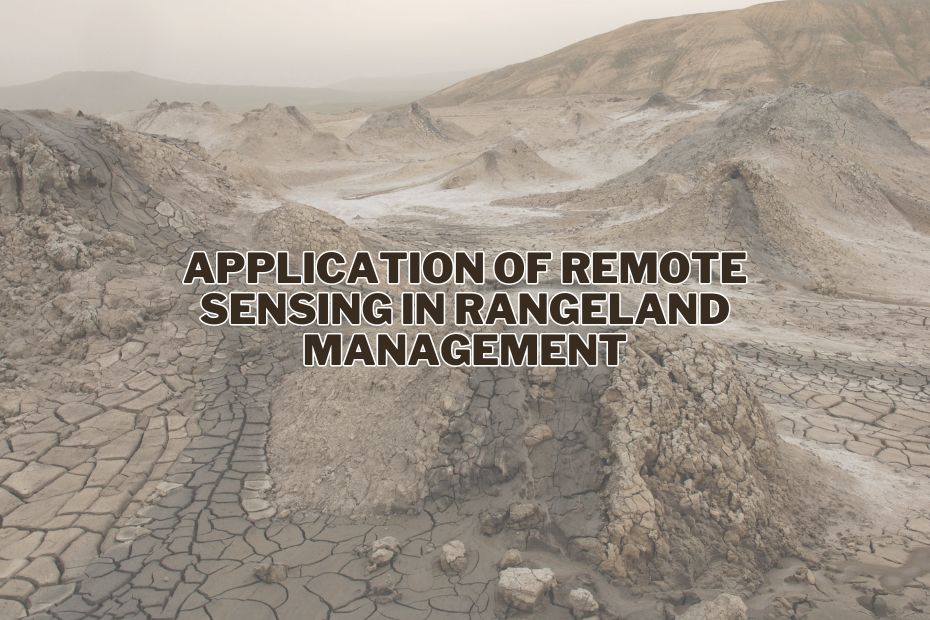Rangelands, vast expanses of open land primarily used for livestock grazing, are crucial ecosystems that provide habitat for wildlife, sustain livestock production, and even play a role in carbon sequestration. Fortunately, modern technology has brought about a revolution in rangeland management, with remote sensing taking center stage. In this article, we will explore the various application of remote sensing in rangeland management, from mapping vegetation cover to assessing soil health and beyond.
Remote sensing in rangeland management involves using satellite technology and sensors to monitor vegetation, grazing patterns, soil health, and more. It aids in wildfire detection, water resource management, invasive species control, and even carbon sequestration monitoring.
Understanding Rangeland Management
Before delving into the applications of remote sensing, let’s establish a clear understanding of rangeland management itself. Rangelands are vast areas of land primarily used for grazing livestock and are essential for food production, wildlife habitat, and carbon sequestration. Effective rangeland management aims to maintain the ecological integrity of these areas while supporting human activities.
Application of Remote Sensing In Rangeland Management
Rangelands encompass a significant portion of the Earth’s land area, supporting countless ecosystems and serving as vital resources for agriculture and wildlife. To effectively manage these landscapes, remote sensing technology has become an indispensable tool. Let’s delve into the various ways in which remote sensing benefits rangeland management.
1. Mapping Vegetation Cover
The first step in managing rangelands effectively is understanding their current state, and this is where mapping vegetation cover comes in. Remote sensing technologies enable the detailed mapping of vegetation types, densities, and health. This data is crucial for identifying areas that are overgrazed, underutilized, or in need of restoration. Satellite imagery, combined with advanced software, can track changes over time, providing a clear picture of vegetation dynamics.
2. Monitoring Grazing Patterns
Grazing is a significant activity in rangelands, but it needs to be managed carefully to prevent overgrazing. Remote sensing helps in monitoring grazing patterns by providing insights into where and how animals are grazing. This information helps in planning rotational grazing systems and ensuring that vegetation is not overused. It’s a vital tool for sustainable livestock management, ensuring that rangelands can continue to support animal life without degrading.
3. Assessing Soil Health
Soil health is a crucial component of rangeland ecosystems. Remote sensing technologies can assess soil moisture levels, organic content, and even predict erosion risks. This information is critical for making informed decisions on land use and conservation practices. By understanding soil health, land managers can take steps to prevent erosion and degradation, ensuring the long-term sustainability of the rangelands.
4. Fire Detection and Management
Wildfires are a significant threat to rangelands. Remote sensing plays a key role in early fire detection and monitoring, which is essential for effective fire management. Satellite imagery can identify hotspots and track the spread of fires in real-time, enabling quicker responses. This technology is invaluable for protecting wildlife, livestock, and vegetation from the devastating effects of wildfires.
5. Water Resource Management
Water is a limited and vital resource in rangelands. Remote sensing assists in mapping and monitoring water bodies, including rivers, lakes, and wetlands. This data is essential for managing water resources effectively, ensuring that both the ecosystem and the needs of the people and animals that depend on it are met.
6. Invasive Species Detection
Invasive species pose a significant threat to the biodiversity and productivity of rangelands. Remote sensing can identify these species early on, allowing for timely intervention. By mapping the spread of invasive species, land managers can implement targeted control measures to protect the native ecosystem.
7. Drought Prediction
Droughts can have devastating effects on rangelands. Remote sensing technologies are pivotal in predicting and monitoring drought conditions. This early warning system enables proactive measures to mitigate the impacts of drought on livestock, wildlife, and vegetation.
8. Wildlife Habitat Assessment
Rangelands are critical habitats for numerous wildlife species. Remote sensing provides detailed information on habitat conditions and changes, which is vital for wildlife conservation efforts. It helps in identifying critical habitats, monitoring wildlife populations, and planning conservation strategies.
9. Erosion Control
Erosion is a significant concern in rangeland management. Remote sensing can identify areas at high risk of erosion, guiding interventions to prevent soil loss. This information is essential for maintaining soil health and preventing land degradation.
10. Carbon Sequestration Monitoring
Rangelands play a role in carbon sequestration, helping mitigate climate change. Remote sensing allows for the monitoring of carbon stocks and fluxes in these ecosystems, providing valuable data for climate change research and mitigation strategies.
Conclusion
Remote sensing has become an indispensable tool in rangeland management. Its applications range from mapping vegetation cover to predicting droughts, each playing a crucial role in maintaining the health and productivity of these vital ecosystems. By leveraging this technology, we can ensure sustainable management practices that protect these lands for future generations.
FAQs: Application of Remote Sensing In Rangeland Management
Can remote sensing predict droughts in rangelands?
Yes, remote sensing technologies are capable of predicting and monitoring drought conditions, enabling proactive measures to mitigate their impacts.
Why is monitoring grazing patterns important in rangeland management?
Monitoring grazing patterns is crucial to prevent overgrazing, ensuring sustainable livestock management, and maintaining the ecological balance of rangelands.
How does remote sensing benefit rangeland management?
Remote sensing technology provides data and insights for mapping vegetation cover, monitoring grazing patterns, assessing soil health, detecting wildfires, managing water resources, and much more. This data enables informed decision-making in rangeland management.
What is the role of remote sensing in wildlife habitat assessment?
Remote sensing helps map and monitor wildlife habitats in rangelands, assisting land managers in conservation efforts and the protection of diverse wildlife populations.
